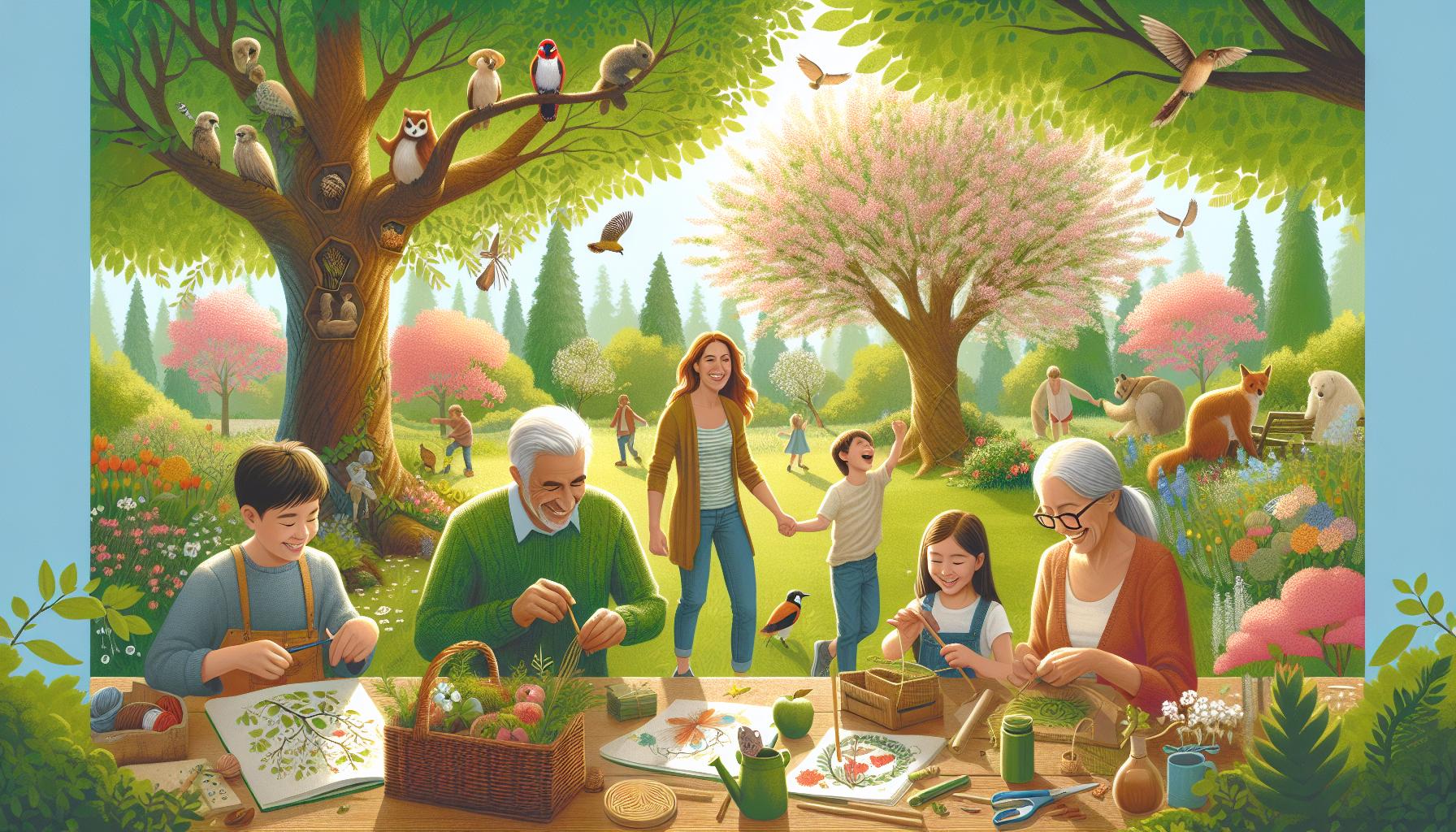Become a Tree Expert in a Snap: Fun Tree Facts and Activities—a title that may sound like a challenge issued to your average lumberjack or a call to action for aspiring arborists,but fear not! You don’t need a PhD in botany to dive into the wonderfully wacky world of trees. In this delightful article, we’ll unwrap some tree-tastic facts that will have you stumping your friends like a seasoned expert in no time. From the woody wonders of the tallest trees to the secret lives of the tiniest seeds,we’ve packed in fun activities and trivia that make learning about trees as easy as finding a four-leaf clover in a forest of three-leafed ones. So, grab your magnifying glass, put on your best tree-hugging sweater, and let’s get ready to branch out into this green universe where knowledge grows on trees!
Understanding the Basics of Trees: An Introduction to Tree Biology and Ecology
Trees are remarkable living organisms that play a vital role in maintaining ecological balance and contributing to the health of our planet. They belong to the kingdom Plantae and are primarily categorized into two major groups: deciduous and coniferous. Deciduous trees shed their leaves annually, adapting to seasonal changes, while coniferous trees, ofen evergreen, retain their needle-like leaves year-round to withstand harsh climates. Each type represents a unique adaptation to their environment, showcasing an array of cellular structures that contribute to their functions such as photosynthesis, respiration, and water transport.
In understanding tree biology, it is indeed essential to appreciate the intricate relationships they maintain with other organisms within their ecosystems. Tree roots not only anchor them in the soil but also engage in symbiotic relationships with fungi, forming networks that enhance nutrient absorption. Additionally, the leaves of trees act as carbon sinks, facilitating the process of photosynthesis, where carbon dioxide is transformed into oxygen, providing essential air for all living beings. Trees also offer habitats for various species and contribute to soil health, thus playing an integral part in the biodiversity of their surroundings. Here are some key ecological roles of trees:
- Air purification: They filter pollutants from the air.
- Climate regulation: Trees help moderate temperatures.
- Soil erosion control: Their roots stabilize the soil.
- Habitat provision: They provide shelter and food for wildlife.
Essential Tree Identification Skills: How to Recognize Common Species in Your Area
One of the most rewarding aspects of exploring nature is the ability to identify the trees that surround you. To enhance your tree identification skills, start by observing the leaves, which can vary greatly among species. Consider the shape, size, and margins of the leaves; for instance, oak trees typically have lobed leaves, while maple leaves are known for their distinctive hand-like shape. Additionally, take note of the bark, as it often provides clues about the tree’s identity. For example, the smooth, light gray bark of a birch tree contrasts sharply with the rugged, furrowed bark of a pine.Observing flowers and fruits can also be helpful, as many species exhibit unique reproductive features that are easily recognizable, such as the acorns of oak trees or the colorful berries of dogwood.
Familiarizing yourself with local tree species can be simplified by creating a reference chart. The following table illustrates some common trees and their identifying characteristics, serving as a rapid guide for budding arborists:
| Tree Species | Key characteristics |
|---|---|
| Red Maple | brilliant red leaves in fall, smooth, light gray bark |
| Black Oak | Dark, furrowed bark, lobed leaves with pointed tips |
| White Birch | White, peeling bark, triangular leaves with serrated edges |
| Pine | Needle-like leaves in clusters, cones as reproductive structures |
By utilizing these physical attributes, as well as local guides and apps, you can build a solid foundation for recognizing the trees in your area. Remember, practice makes perfect—so get outside, take notes, and enjoy the process of becoming well-versed in tree identification!
The Importance of Trees: Exploring Their Environmental Benefits and Ecosystem Roles
Trees play an indispensable role in our environment, serving as vital components of ecosystems across the globe. They are often referred to as the “lungs of the Earth,” as they absorb carbon dioxide and release oxygen—essential processes that mitigate climate change and promote air quality. Actually, a mature tree can absorb approximately 48 pounds of carbon dioxide per year.Additionally, trees provide habitat and food for countless species, from birds and insects to mammals, contributing significantly to biodiversity. Their vast root systems are instrumental in preventing soil erosion and maintaining the integrity of watersheds by filtering pollutants and managing stormwater runoff.
Beyond their environmental contributions, trees offer a variety of ecosystem services that are often overlooked. These include:
- Shade and Cooling: Trees can reduce temperatures in urban areas by up to 10°F, helping to lower energy costs and combat the urban heat island effect.
- Soil Enrichment: Through a process known as leaf litter decomposition, trees enhance soil fertility by adding organic matter.
- Wildlife Corridors: Tree canopies connect fragmented habitats,allowing species to migrate and thrive.
- Aesthetic Value: The presence of trees in urban landscapes improves mental health and well-being, fostering a sense of community.
| Tree Type | Carbon Absorption (lbs/year) | Height (ft) |
|---|---|---|
| Oak | 50 | 60-100 |
| Pine | 45 | 50-70 |
| maple | 48 | 30-100 |
Fun and Engaging Activities: Hands-On Ways to Connect with Trees and Nature
Engaging with trees and nature can be both enlightening and fun. One way to enhance your connection is through tree identification walks. Grab a field guide or a tree identification app and venture into your local park or forest.As you walk, take note of the leaves, bark, and any fruits or flowers. Focus on these key features to determine the species you encounter. For a more exciting challenge, you can create a tree bingo card before you head out, marking off species as you spot them.Invite friends or family to join you in this adventure and add a friendly competition element to your exploration!
Another captivating way to engage with nature is through tree journaling. Equip yourself with a notebook and some colored pencils or watercolors to document your discoveries. For inspiration, consider these prompts:
- Sketch the bark texture of trees you find.
- Write down why specific trees are meaningful to you.
- Create a list of the various wildlife you observe in and around the trees.
You’ll not only deepen your understanding of the unique characteristics of different trees but also cultivate a lasting thankfulness for the beauty of nature. To make this activity even more rewarding, you could form a tree-sharing group where participants can exchange their findings and experiences.
Tree conservation: Understanding the Threats and How to Protect Our Forests
Forests play a crucial role in our ecosystem, yet they face numerous threats that compromise their health and longevity. Deforestation,driven by agriculture,urban advancement,and logging,leads to habitat loss for countless species and disrupts the natural balance of ecosystems. furthermore, climate change accelerates these threats, causing changes in temperature and precipitation patterns that stress trees and contribute to pest infestations and diseases. Around 18 million acres of forest are lost each year, highlighting the urgent need for action to safeguard these vital natural resources.
Protecting our forests requires collaborative efforts and informed actions.communities can engage in tree planting initiatives, where locals come together to plant native species that are well-adapted to their environment. Supporting sustainable forestry practices can also make a notable difference, as they ensure that logging is done responsibly and biodiversity is preserved. Moreover, increased awareness about the importance of trees can drive initiatives like urban greening projects that integrate trees into cities, thus enhancing air quality and overall urban climate. Simple lifestyle adjustments, such as opting for eco-friendly products and advocating for stronger conservation laws, can collectively contribute to protecting our planet’s invaluable forest resources.
Exploring the World of Urban Forestry: Trees in the City and Their Unique Challenges
Urban forestry is an intriguing field where nature and city life intersect, presenting unique challenges that require innovative solutions. Trees in urban settings face a myriad of obstacles, including limited space, pollution, and competition for resources. Additionally, their role transcends mere aesthetics; urban trees contribute significantly to improving air quality, reducing heat islands, and enhancing overall community well-being. In cities, where green space is often scarce, understanding how trees adapt and thrive is crucial for successful urban planning and environmental health.
To better appreciate the hardships faced by urban trees, consider their specific needs and the ways we can support them. Some key challenges include:
- Soil Compaction: Heavy foot and vehicle traffic compresses the soil, making it tough for roots to grow.
- Limited Root Space: Urban infrastructure frequently enough restricts the area for root expansion, leading to stunted growth.
- Pollution: Air and soil pollutants can hinder tree health and longevity.
Engaging the community in tree care and education fosters a sense of stewardship.Various activities, such as tree planting days, workshops on proper pruning techniques, and educational walks, can nurture appreciation for these natural giants and build awareness about their vital role in urban ecosystems.
Educational Resources: Recommended Books, Apps, and Websites for Aspiring Tree experts
For those looking to deepen their understanding of trees and forestry, a variety of enriching resources are available. books remain an invaluable source for aspiring tree experts. Consider diving into titles such as The Hidden Life of Trees by Peter Wohlleben,which explores the complex social life of trees and their interconnectedness. Another excellent advice is Botany for Gardeners by Brian Capon, which simplifies botanical principles and is perfect for beginners keen on understanding how trees grow and thrive. Together, these books provide a solid foundation and inspire a greater appreciation for the natural world.
Along with books, apps and websites can enhance your learning experience. The free app Tree ID is a fun and interactive way to identify trees in your area with just a few clicks. Furthermore, websites like Arbor Day Foundation and trees for the Future offer a wealth of articles, guides, and community resources tailored for tree enthusiasts. For a more hands-on experience, consider joining local tree care workshops or online forums to collaborate and share insights with fellow nature lovers.Here’s a quick overview of some resources:
| type | Name | Platform |
|---|---|---|
| Book | The Hidden Life of Trees | Print / eBook |
| Book | Botany for Gardeners | Print / eBook |
| App | Tree ID | Mobile |
| Website | Arbor Day Foundation | Online |
| Website | trees for the Future | Online |
Joining the Community: Finding Local Groups and Events to Enhance Your Tree Knowledge
Diving into the world of trees doesn’t have to be a solitary journey. By connecting with local groups and attending events, you can enhance your knowledge and enjoy the camaraderie of fellow tree enthusiasts. Many communities host tree walks, workshops, and educational seminars where you can learn about native species, sustainable practices, and ecology. Look for organizations such as local arboretums, botanical gardens, or nature centers, which often offer programs focused on regional flora and conservation efforts. Consider joining online platforms like Meetup or Facebook Groups to discover local clubs dedicated to tree identification, nature photography, and citizen science projects.
To streamline your search, check out community calendars or websites that list upcoming events. you might find exciting opportunities such as:
- Tree Planting Events: Participate in local planting initiatives to contribute to community greening efforts.
- Forest Workshops: Engage in hands-on learning about tree care and maintenance techniques.
- Nature Festivals: Attend events celebrating local ecosystems, featuring expert speakers and guided tours.
Additionally, joining online forums or subscribing to newsletters of local conservation groups can keep you informed about upcoming events and new discoveries in the tree community. Each connection made and experience shared can deepen your understanding and appreciation of the splendid trees that surround us.
Frequently asked questions
What are some surprising facts about trees that everyone should know?
Trees are often seen merely as background scenery, but they are interesting organisms with astounding capabilities. As a notable example, did you know that trees communicate with one another through a network of underground fungi called the mycorrhizal network? This “wood Wide web” allows trees to share nutrients and even warn each other about pests and diseases. Research has shown that trees can send distress signals about insects or environmental stress, showcasing a form of social behavior that is both complex and remarkable.
Another intriguing fact is that the oldest known living tree is a bristlecone pine named Methuselah,located in California. It is estimated to be over 4,800 years old, providing insight not only into the longevity of trees but also into the historical climate conditions they have survived. Moreover, trees play a crucial role in regulating our climate; a mature tree can absorb approximately 48 pounds of carbon dioxide per year, which contributes significantly to mitigating climate change. Understanding these facts helps emphasize the value trees hold in both our ecosystems and our daily lives.
How can I effectively learn about different types of trees?
Becoming knowledgeable about various tree species can be an enjoyable and engaging process. Field guides are a fantastic starting point; they often include visual aids such as illustrations and photographs to help you identify trees based on bark texture, leaf shape, and flower colors. For beginners, a tree identification app can also be an excellent resource. Many of these apps utilize artificial intelligence to help you identify trees through images that you capture.
Another effective way to gain knowledge is by participating in local tree walks or community workshops. Many regions offer programs through forestry departments or local parks aimed at educating the public about native tree species. These hands-on experiences provide practical knowledge,allowing you to ask questions directly to experts in the field. Additionally, volunteering for tree planting or maintenance projects can foster a deeper understanding as you interact with diverse species in various stages of growth. Engaging with trees in these ways makes learning feel less like a chore and more like a fun, exploratory adventure.
What activities can help kids become interested in trees?
Engaging children with trees through fun activities can foster a lifelong appreciation for nature. One exciting activity is creating a tree scavenger hunt. This can involve identifying different types of leaves, finding specific bark textures, or spotting various fruits or flowers. By making a game out of exploration, kids are more likely to retain their interest and learn together. You can even incorporate a reward system to motivate them further, such as stickers or small prizes for every type of tree they identify.
Another creative avenue is art projects that use leaves or bark as materials. Kids can gather fallen leaves to create leaf rubbings or collage artwork, helping them connect physically and artistically with what they are studying. Additionally, storytelling can bring trees to life; reading books about trees or nature can incorporate important ecological lessons in a relatable way.Activities like these not only make tree learning fun but also enhance creativity, nurture curiosity, and build a foundational understanding of ecological concepts.
What is the ecological importance of trees in our environment?
Trees play a pivotal role in maintaining the environmental balance of our planet.One of their key functions is carbon sequestration; they absorb carbon dioxide during photosynthesis, which helps combat climate change. It’s estimated that one mature tree can absorb around 48 pounds of carbon dioxide annually, collectively making a significant impact when considering the vast number of trees worldwide. According to the World Resources Institute, forests cover about 31% of the planet’s land area, illustrating their potential for global carbon storage.Moreover, trees contribute significantly to our water cycle. They help regulate local climates by absorbing and intercepting rainfall, which can contribute to reducing the risk of flooding. In addition, tree canopies play a crucial role in providing shade, which lowers ground temperatures significantly. This not only benefits local wildlife but also helps in reducing energy costs in urban environments by cooling homes and buildings naturally. Ultimately, the ecological roles trees play are indispensable for sustaining biodiversity, preserving habitats, and maintaining the health of our planet.
How can tree planting initiatives make a difference in communities?
tree planting initiatives can profoundly impact both the environment and community cohesion. For one,they greatly enhance air quality by filtering pollutants and producing oxygen. A study by the US Forest Service indicates that urban trees can absorb over 1 million tons of air pollution every year. Additionally, they provide critical shade that can lower surrounding temperatures, which is particularly beneficial in urban areas where heat islands are prevalent.
Beyond environmental benefits, tree planting projects can also strengthen community ties.These initiatives often involve volunteers and local groups, fostering a sense of camaraderie and shared responsibility for the environment. Furthermore, they can improve property values, create more attractive neighborhoods, and even provide spaces for recreation and relaxation. the simple act of planting trees can thus catalyze a ripple effect,leading to enhanced community well-being and ecological benefits that span generations.
What resources are available for aspiring tree experts?
Aspiring tree experts have a wealth of resources at their disposal to enhance their understanding of trees. Online courses offered by universities and environmental organizations are an excellent way to gain structured knowledge. Websites such as Coursera and edX provide courses on botany and ecology,which frequently enough include sections focused specifically on trees. These courses typically feature assignments and discussions that deepen comprehension, even for beginners.
Books also remain invaluable tools; titles like “The Tree book” by Tony R. D’angelo present in-depth insights into tree identification, care, and ecology.Additionally, engaging with local arboreta or botanical gardens can offer practical exposure, where you can observe trees up close and attend workshops led by experts. joining local tree advocacy groups or participating in citizen science projects related to trees provides both knowledge and a sense of community involvement. These resources create a solid foundation for anyone eager to become an informed advocate for trees and their conservation.
In Retrospect
As we conclude our journey into the fascinating world of trees,remember that you don’t need a degree in botany to appreciate these magnificent giants. By equipping yourself with fun facts and engaging activities, you’ve taken the first step toward becoming a tree expert in no time. With over 60,000 different species worldwide, each tree tells its own unique story and plays a vital role in our ecosystem—from producing oxygen to supporting wildlife habitats.
Whether you choose to explore your local forest, participate in community tree planting, or simply observe the variety of trees in your neighborhood, every small action contributes to a greater understanding and appreciation of nature. so, grab a field guide, gather your friends and family, and dive into the green wonders around you. In this digital age, there’s no shortage of resources at your fingertips—use them to enhance your knowledge and inspire others to join you on this journey. Together,let’s nurture not just trees,but a lifelong reverence for the natural world.






